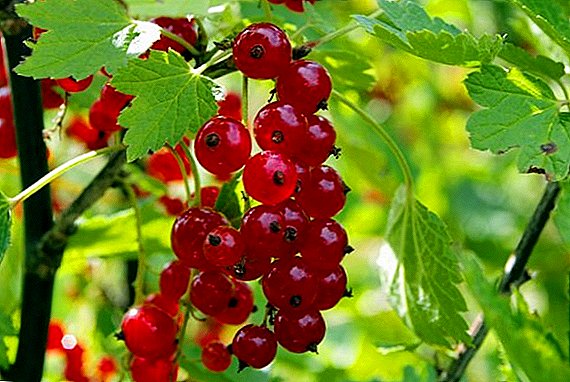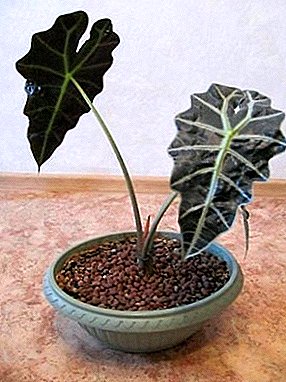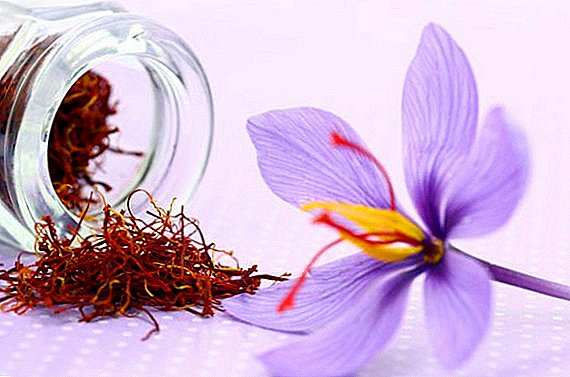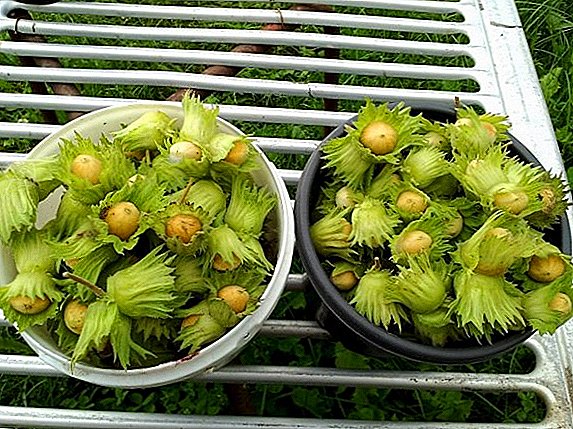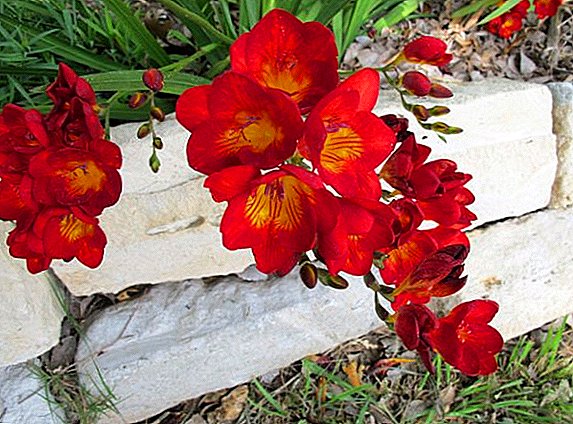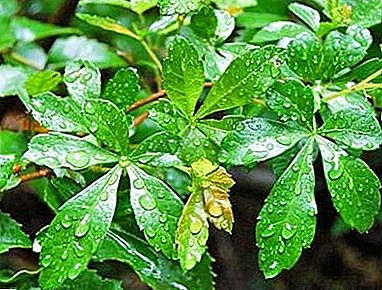
"Cissus" - a decorative leafy plant.
Beginner growers love him for his unpretentiousness and excellent home growth.
The flower prefers frequent abundant watering, feeding and spraying.
General description of the plant
"Cissus" refers to unpretentious home plants. Valued for its impartiality. The flower is widely distributed in Russia, Ukraine, Belarus.
 It is grown in the ample way. Great for growing in hanging pots or deep pots. It is an excellent decor green corner.
It is grown in the ample way. Great for growing in hanging pots or deep pots. It is an excellent decor green corner.
In the wild, it can grow in tropical forests in South Africa. Homeland - South Africa. Most of the subspecies of this wonderful plant are climbing evergreen vines.
Thanks to the antennae, the grapes clings to handrails and supports. The leaves of this flower are wide, whole, dissected in the middle. Even with good care, flowering is very rare. Flowers inconspicuous, miniature. They are bundled in small false umbrellas.
The plant is valued for its abundant delicate flowering. Experienced flower growers often call a flower room birch and home grapes (for more information about “birch”, you can find out as a home plant here).
Reference! Latin name: "Cissus". It belongs to the “Vitaceae” family.
This flower family includes about three hundred species of various flowers and plants. The most popular types of Cissus are: Antarctic, Multicolored, and Rombolic.
Types of "Cissus"
"Antarctic"
Most often found in the offices of organizations or private apartments. Latin name: "Cissus antarctica". It is unpretentious evergreen plant, grassy vine. Prefers a shadow. Does not tolerate temperature differences. May die at temperatures below 5 ° C. It tolerates dry air and hot weather.
Oval-shaped leaflets. In length reach no more than 9-11 cm. The edge of the leaves is toothed, emerald hue. Petioles, branches and antennae - terry, with dense pubescence, brown. Flowers tiny, emerald. Collected in dense corymbose inflorescences.
In the photo "Cissus Antarctic":
Multicolored
Requires more care than other subspecies. Latin name: "Cissus discolor". In winter, it grows at a temperature of 16-24 ° C. Does not like dry air, requires spraying. Endowed with emerald leaves with small gray specks.
The shape of the leaves in the form of arrows. Bottom sheet plate light pink shade. The edge of the leaves is notched. At rest in the winter can abundantly shed leaves. Stems require normalization. In the spring after a heavy pruning grows with a new force.
In the photo "Cissus Multicolored":
Diamond Shaped (Quadrangular)
It is a grassy liana. Latin name: "Cissus rhombifolia". The leaves are tripartite. Have the form in the form of a rhombus. The edge of the leaves is toothed, emerald hue. The plant has a creeping antennae.
Stems and fleecy twigs. The flowers are miniature. Racemes inflorescences. After flowering, brown edible berries remain. In room conditions, even with good care, does not bloom. Care at home for "Cissus Rombolistnym" will not bring special surprises and is not much different from other species.
In the photo "Cissus Rhombus (Quadrangular)":
Home care
The video contains a detailed description of home care for the Cissus vine:
Plant growth
 In good conditions, all the subspecies of this plant grow rapidly. With the help of numerous emerald stems, the antennae easily twist the supports.
In good conditions, all the subspecies of this plant grow rapidly. With the help of numerous emerald stems, the antennae easily twist the supports.
The plant can grow in greenhouses, winter and botanical gardens. The flower covers the ground, snags, natural stones with large lashes of shoots.
This representative of the flora is used to decorate offices and public spaces. Can grow in deep pots and hanging pots.
Watering
The plant quickly evaporates moisture due to the large number of large-scale leaves. Therefore, the flower prefers frequent abundant watering in spring and summer. Water must be defended and soft.
Landing
For planting, you can use the purchase of land for home flowers. Also, the soil can be prepared by yourself. This will require turf and leaf ground.
Fine-grained sea sand, peat and humus are added to the substrate.
Acidity of the soil should be in the range of 5.9-6.2 pH. The environment should be neutral. You can not contain a flower with a strong acid soil.
In such conditions, the plant will not grow. For planting choose deep tanks.
Transfer
 Flowers are transplanted immediately after the rest period. It is necessary to have time to active growth. Transplantation is carried out in the spring.
Flowers are transplanted immediately after the rest period. It is necessary to have time to active growth. Transplantation is carried out in the spring.
Adult flowers are transplanted into deep containers 1 time in 2-4 years. It is important that the roots completely fill the container.
In this case, the pots choose larger sizes. At the bottom is always poured drainage of broken bricks or natural stones. The transplant procedure is carried out by the method of transshipment. It is important that the root system is not affected.
Attention! "Cissus" refers to fast-growing vines. Therefore, he actively consumes vitamins and soil minerals.
Because of this, fertilizing is done every 10-15 days, from mid-spring to mid-autumn. In this case, purchased liquid fertilizers are used.
Breeding
Reproduction occurs stalks or root division. Procedures are carried out at a convenient time. But it is not recommended to touch this representative of the flora in the rest period. Rooting can be done both in soil and in water.
Initially, you can plant several stalks into one container. After, when they begin to actively grow, they are transplanted into separate containers. Thanks to this procedure, a magnificent bushy bush is obtained. Cuttings must be kept in mini-greenhouses at a temperature of 19-21 ° C. Reproduction by dividing the bush produced in the spring during transplantation.
Temperature
 The most optimal temperature for growth is 16-26 ° C. A multi-colored subspecies can grow at a temperature not lower than 16 ° C.
The most optimal temperature for growth is 16-26 ° C. A multi-colored subspecies can grow at a temperature not lower than 16 ° C.
Antarctic does not like drops, but can successfully overwinter at low temperatures. Dies at temperatures below 5 ° C.
In winter, you can not keep flowers in the wind and drafts.
With a strong supercooling, Cissus begins dropping leaves abundantly.
Lighting
The plant loves to grow on the southern sides. Actively goes to growth, as near the window, and in a small distance.
Prefers bright natural light. Can adapt to grow in the shade.
But in a bright room the leaves of this representative flora are richer and thicker.
Pests
With poor care on the flower can start a spider mite. It is washed off with soapy water. Also, a leaf louse can be affected.
It should be noted that the chemical treatment is carried out carefully and very carefully, since most of the sub-species of "Cissus" leaves are very sensitive to various components.
Plant diseases
 Diseases occur only with improper care. If the leaves of "Cissus" strongly bent and began to dry, then the air around the flower is too dry. It is necessary to put the pot on a container with wet moss, and spray the leaves with water from the sprayer.
Diseases occur only with improper care. If the leaves of "Cissus" strongly bent and began to dry, then the air around the flower is too dry. It is necessary to put the pot on a container with wet moss, and spray the leaves with water from the sprayer.
If the leaves have lost their color, and the growth of the plant has slowed down a lot - the flower lacks vitamins and trace elements. It is necessary to fortify the soil and start feeding. With the active discharge of leaves, the plant must be removed from a cold room or drafts.
The video describes in detail the symptoms of the disease "Cissus" and ways to combat them:
- Syngonium;
- Dikhorizandra;
- Tetrastigma Vouinier;
- Duchenei Tutti Frutti Indian;
- Ruellia;
- Setcreasia Violet (purple);
- Money plant (Potos);
- Tolmia;
- Tunbergia;
- Philodendron.
The evergreen cissus creeper is propagated by stalks or by dividing a bush. Actively grows and grows in bright natural light. Requires transplants 1 time in 2-4 years. Prefers additional feedings in the form of liquid fertilizers. At home, does not bloom.



